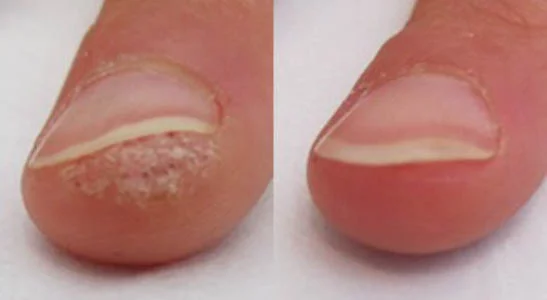Warts are caused by infection of skin or mucosa by human papillomaviruses (HPV) and appear as small, fleshy growth or bumps, involving anywhere part of the body. The medical term called Verruca.
Wart viruses are contagious. The mode of transmission is from direct person to person contact or indirectly fomites. Public places like swimming pools and bathrooms are the common areas for the spread of warts.we can remove warts wit various types of wart removal treatment.
HPV viruses cause the excessive and rapid growth of keratin, which is a hard protein on the top layer of the skin. There are different strains of HPV causing warts in different parts of the body.Each type appears on a different part of the body and has a distinct appearance. The most common type of warts is mentioned below:
Common warts or Verruca Vulgaris: Common warts are most often on the back of hands, foot involving mainly fingers and toes, but can appear elsewhere. They are firm and have a rough surface, slightly grayer than normal skin. They are small from pinhead to a pea and size ranging from < 1mm to 1cm in diameter. They may have black dots on the surface (like seeds), which are really tiny blood clots.
TPlantar warts: Plantar warts grow on the soles of the feet. Unlike other warts, the pressure from walking and standing makes them grow into your skin. They are flat, tough, and tick with black dots on the surface and may appear as single or cluster.Plantar warts can make walking uncomfortable and may confuse with calluses. Multiple plantar warts in a large cluster called as mosaic warts.
Plane warts or Verruca plana: Flat warts tend to appear on children’s face, men’s beard areas, and women’s legs. They are very small with a flat top surface and are skin-colored to slightly brown or yellow.
Filiform Warts: They appear as thread-like and spiky or tiny brushes involving around the mouth, eyes, and nose or chin and can be irritating due to their involvement of sensitive areas of the face.
Genital Warts: They appear as small, scattered, skin-colored bumps or like a cluster of bumps (cauliflower) on your genitals. A few strains of HPV that may be passed sexually can cause warts in and around genitals can eventually lead to cervical cancer, a potentially fatal disease. Periungual Warts grow around and under the toe or fingernails. They can be painful and affect nail growth.
Warts are highly contagious and mainly spread by direct skin contact. The best way to prevent is by stopping the spread of infection from one person to another and or from one part of the body to another in the same individual.
HPV vaccine prevents cervical cancers and genital warts.
If left untreated, the wart may spontaneously clear at any time from a few months to a year, but in some cases, it may lead to spread of infection, secondary bacterial infection, involving the soft tissues causing pain and rarely malignancy in genital strains of HPV
Treatment includes simple measures to limit the spread of infection, prevention, medication, and interventional treatments. Many people with a good immune system don’t require treatment as the lesions resolve spontaneously without medical intervention. However, it justifies treating as it is a contagious disease; and can spread from one area to another in the same individual.
Topical treatments are regarded as first-line therapy. Topical cream such as retinoic acid cream, salicylic acid preparations, 5-FU, podophyllotoxin cream (anogenital warts). diphencyprone (DCP) and imiquimod irritate the skin and encourage your immune system.
Oral immunomodulators such as levamisole and zinc sulfate are used which have an effect on the immune system for any kind of warts. Antiviral cidofovir ( topical or intravenous or intralesional ) are used in very severe involvement of warts.
Occlusion: duct tape occlusion involves covering the wart with a small piece of duct tape for a period of 2 months. This therapy can be used for common or plantar warts, and in combination with topical therapy enhance the results.
Dermatological or Interventional therapy for warts is advised if medical therapy fails to work or our body’s immune system does respond to the infection to heal on its own. Intralesional immunomodulator, interferon is used to boost your immune system to fight against HPV, typically for genital warts. Intralesional cytotoxic agent bleomycin may stop infected cells to replicate. These intralesional therapies are used in recalcitrant warts.
Chemical cautery using high concentrated trichloroacetic acid, silver nitrate, phenol, cantharidin, formic acid. Cantharidin liquid is often used in young children, as it doesn’t cause pain. After application blister is formed underneath it, lifting it off the skin.
Photodynamic therapy: topical or systemic aminolaevulinic acid is taken up by dividing cells, metabolized to protoporphyrin, and then photoactivated to produce damage effect on the cell in an infected area of wart.
Cryotherapy: involves freezing the wart with liquid nitrogen. Freezing causes a blister to form under and around wart which in due time lifts the wart away from the skin. The procedure is a little painful, probably need more than one session. It usually works well but can cause discoloration and scarring in dark skin.
Surgery is usually only considered if the above treatment doesn’t work. There are different surgical options for removing warts, usually done after giving local anesthesia and are mentioned below:
Curettage is scraping off the wart with a sharp knife.
Electrosurgery: This is using a small probe with an electric current to cauterize the skin tissue. It works well for common warts, filiform warts, and foot warts.
Excision: surgical excision using a sharp blade and closure.
Laser surgery: by using ablative lasers such as co2 and erbium YAG laser to destroy warty tissue.
However, among these radio-frequency is the cheap and best method to remove or cauterize warts.
We at Clear Skin Centre use the simplest way to remove warts, by electrosurgery using the advance technology Ellman radiofrequency device. The procedure is done on an outpatient basis with the highest safety measures. We recommend the earliest intervention, with the appearance of a single lesion of a wart, as to avoid spreading from one area or person to another.
| DO | DON'T |
|---|---|
| Do try to get-rid of them at the earliest | Do not try to remove the wart by your own. |
| Do maintain good self-hygiene & keep your hand & feet dry | Do not pick or scratch your warts |
| Do keep your skin intact, if the skin has been cut or opened the virus is more likely to enter | Do not share towels, clothing, socks, or soaps with others |
| Do cover warts with a plaster or bandage | Do not walk bare-foot in public places, if you have a plantar wart |
| Do wash your hands regularly | Do not shave or do electrolysis where the wart are located |
| Do get warts evaluated promptly | Do not share your sports gear |
| Do check children’s feet frequently for warts | Do not bite your fingernails or the cuticles |
| Do consult the dermatologist | Do not try home-remedies |
| Do wear waterproof shoes or sandals (flip-flops) in public showers and pools or in a locker room | Do not have sexual contact if you have warts in the genital area |

